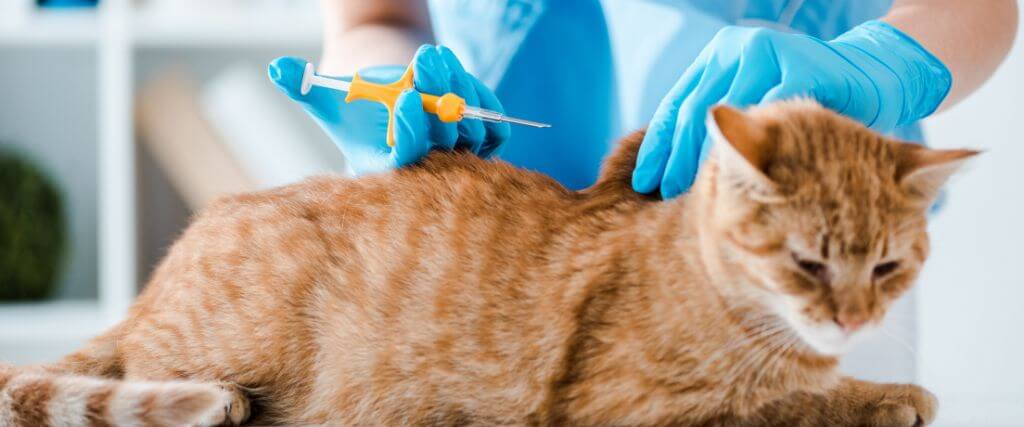May is Chip Your Pet Month to spread awareness about the importance of microchipping your furry (or feathered or scaled!) friend. To celebrate this month-long event, we’d like to share the answers to some of the most common questions we hear about this potentially life-saving procedure. A microchip is a tiny rice-sized device implanted under your pet’s skin with a unique identification number. When linked to your contact information in a microchip registry, this number becomes a powerful tool for reuniting you with your beloved companion if they get lost.
As veterinarians, we enjoy reuniting lost pets with their owners thanks to microchips. However, many pet owners have questions about this process. In this blog post, we’ll address some of the most common questions about microchipping. Let’s go!
1. Is Microchipping Painful for My Pet?
Microchipping is not painful. The microchip is inserted with a needle similar to those used to administer vaccines. It’s a very quick procedure, often over before a patient realizes anything happens. There is no need for anesthesia or sedation, and pets typically experience, at most, minor discomfort.
.jpg)
2. How Much Does Microchipping Cost?
The cost of microchipping can vary depending on your location and clinic. However, it is affordable on most budgets. The cost of microchipping at Plymouth Veterinary Hospital when this blog is being published is $87.55 (please note that the price can change at any time). Contact us to request an exact price quote.
3. Will a Microchip Track My Pet’s Location?
Unfortunately, no. Microchips do not have GPS tracking capabilities. They only store the unique identification number linked to the registry database. It is not feasible to manufacture a chip with GPS capabilities that’s small enough to be injected under the skin. And even if making such a device were possible, the cost would be prohibitive for many pet owners. GPS trackers also require a power source, while microchips are passive devices that don’t need a battery.
4. What Happens During a Microchipping Appointment?
Microchipping appointments are usually quite quick and straightforward. Your veterinarian will first perform a brief physical exam to ensure your pet is in good general health. Then, they’ll use a scanner to ensure no existing microchips (some pets may be adopted with a microchip already implanted). Finally, they inject the microchip into their shoulder blades using a syringe. The staff at your vet’s office will also help you register the chip with your contact information and answer any questions.
There is no need for downtime following the procedure, so your pet can resume their normal activities immediately after being microchipped. The entire process generally only takes a few minutes.
.jpg)
5. My Pet Already Has a Collar and ID Tag. Isn’t That Enough?
Collars and ID tags are crucial for identifying your pet, and we always recommend using them — even if you have your pet microchipped. However, collars can fall off, and the same goes for tags. Conversely, a microchip is a permanent and reliable form of identification that can’t be lost or removed.
6. What Happens If My Pet Gets Lost with a Microchip?
If your microchipped pet gets lost and is brought to a shelter or veterinary clinic, an employee or veterinarian will scan your pet for a microchip. Animal control officers may also scan lost pets for microchips.
Once a chip is detected, its unique identification number will be used to access your contact information in the microchip registry. Someone will then contact you to reunite you with your beloved companion.
7. How Do I Update My Contact Information if I Move or Change My Phone Number?
It’s crucial to keep your contact information up-to-date in the microchip registry. This ensures someone can contact you if your pet ever gets lost. Most microchip registries allow you to update your information online or by contacting them directly. Ensure your pet’s microchip number and current contact information are readily available. This step is crucial, so if you move or have a change in phone numbers, make sure you update the registry immediately.
8. Can a Microchip Migrate Within My Pet’s Body?
While uncommon, microchips can migrate slightly under the skin. However, they remain functional and can still be detected by scanners. If you are concerned about your pet’s chip moving, ask your veterinarian to scan them during their wellness appointments. This will provide peace of mind that the microchip is still exactly where it belongs and functioning correctly.
9. Can I Have a Pet Other Than a Cat or Dog Microchipped?
Absolutely! Microchipping is typical for smaller pets, like rabbits, ferrets, and pocket pets. It is also suitable for larger animals like horses. Some veterinarians will even microchip reptiles and birds. If you have an unusual pet, talk to your veterinarian to determine whether microchipping suits them.
Conclusion
Microchipping is a safe, simple procedure that can offer you and your pet peace of mind. We hope to encourage more pet owners to take this important step by addressing common concerns.
Schedule a microchipping appointment during Chip Your Pet Month and give your furry friend the best chance of finding their way back home if they ever get lost. Contact us today to schedule an appointment to have your four-legged best friend microchipped or to learn more about this life-saving procedure.
If you have questions and want to contact us, you can call us directly at 734-453-0485 or email us at [email protected]

